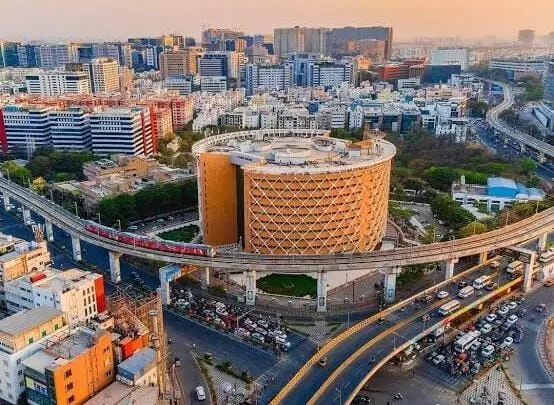Hyderabad emerges as fastest-growing office market in India: Knight Frank
As of June 2025, the city’s total office stock reached 123 million square feet, accounting for 12 per cent of India’s total office market
By Sri Lakshmi Muttevi
Hyderabad emerges as fastest-growing office market in India: Knight Frank
Hyderabad: Hyderabad is solidifying its position as one of the leading metro cities in India for rapid office market expansion, registering the highest growth among the top metros in the country.
As of June 2025, the city’s total office stock reached 123 million square feet, accounting for 12 per cent of India’s total office market.
This growth represents a compound annual growth rate (CAGR) of 9.2 per cent, the highest among the top six metros, according to a report by real estate consultancy Knight Frank India.
Office stock to surpass one billion sq ft by Q3 2025
The report highlights that India’s total office stock is poised to surpass one billion sq ft by Q3 2025, a major milestone for the country’s commercial real estate sector.
As of H1 2025, the combined office stock across the top eight Indian cities stood at 993 million sq ft. From under 200 million sq ft in 2005 to nearly 1 billion sq ft in 2025, India’s office supply has grown at a CAGR of 8.6 per cent over the last two decades.
Metro-wise contribution to office stock
Among major metros, Bengaluru leads with 229 million sq ft, contributing 23 per cent to the total office stock. It is followed by the National Capital Region (NCR) with 199 million sq ft (20%) and Mumbai with 169 million sq ft (17%).
Together, these three cities comprise 60 per cent of the country’s total office supply.
Hyderabad, along with Pune and Chennai, contributes 33 per cent, while Ahmedabad and Kolkata make up the remaining 7 per cent. Mumbai and Pune have recently touched record highs in office transaction volumes, while Hyderabad has reached a post-pandemic peak.
Breakdown of office inventory
India’s total office inventory is currently valued at Rs 16 trillion (USD 187 billion).
Of this, Grade A office spaces constitute 53 per cent, followed by Grade B at 43 per cent, and Grade C at 4 per cent.
Cities like Bengaluru and Hyderabad boast the highest concentration of Grade A properties, while Mumbai and Kolkata—being older office markets—highlight the need for modernization and upgrades.
Hyderabad’s office stock is concentrated in HITEC City and Kondapur
Hyderabad’s office stock, now at 123 million sq ft, reflects its rapid rise, backed by the highest CAGR of 9.2 per cent among India’s top metro cities. A significant portion of this is concentrated in HITEC City and Kondapur, which together account for 47 per cent, while Gachibowli contributes another 41 per cent.
Hyderabad’s growth is driven by tech-enabled workspaces, scalable infrastructure, and competitive rental rates, all of which continue to attract global corporations and investors. This has positioned Hyderabad as India’s fastest-growing office market, with strong investment traction and future potential.
Cost Advantage: declining rents
The Knight Frank report also points to India’s continued cost advantage in the global office space market. Average monthly rents are projected to decline to USD 0.96 per sq ft in 2025, further boosting India’s appeal for multinational corporations.
The combination of affordability and increasing Grade A office supply has accelerated the growth of Global Capability Centres (GCCs) and reinforced India’s importance in multinational real estate strategies.
Sustained office demand amid global challenges
Despite ongoing global economic uncertainties, office demand in Q1 2025 in India showed a notable uptick, underlining the positive business sentiment prevailing across industries. Leadership teams from major firms such as TCS, Infosys, Wipro, HCL Technologies, and Reliance are playing an active role in pushing for a return to the office.
As India maintains its status as a global growth leader, the office space segment is expected to continue its upward trajectory. Apart from some constraints in supply, the sector shows minimal headwinds and is well-positioned to sustain momentum through the rest of 2025.